Okayama University Research: Magic bullet vaccine for cancer treatment
September 25, 2014
Source: Okayama University, Planning and Public Information Division
For immediate release: 30 September 2014
(Okayama, Japan, 30 September 2014) Research highlights in the September issue of the Okayama University e-Bulletin include a novel vaccine for cancer treatment; anti-aging properties of drinking hydrogen-rich water; shoulder and elbow surgery; self-assembling peptide hydrogel; turning ‘junk DNAs’ into genetic markers; photoelectric films for retinal prosthesis. This research is featured in the September 2014 issue of the Okayama University eBulletin: //www.okayama-u.ac.jp/user/kouhou/ebulletin/
Featured research
Ad-REIC vaccine: A magic bullet for cancer treatment
Hiromi Kumon
Director, Innovation Center Okayama for Nanobio-targeted Therapy (ICONT) Okayama University Graduate School (Department of Urology)
Direct targeting and induction of immunological attacks on cancer cells are two widely used approaches for the treatment of cancer. But Professor Hiromi Kumon and colleagues at Okayama University have developed a third and potentially more effective approach based on Reduced Expression in Immortalized Cells (REIC)—a tumor suppressor gene discovered at Okayama University. “In 2005 researchers at the Okayama University Medical School forced its expression using adenoviral vector (Ad-REIC) and discovered it caused selective death (apoptosis) of prostate cancer cells without damaging normal cells,” explains Kumon. “Our approach is a combination of targeting and immunology for the treatment of cancer. Some people have referred to this as a ‘magic bullet’. We are working with international partners to develop an Ad-REIC/DKK3 vaccine to treat various intractable solid tumors.”
The important aspect of cancer treatment using Ad-REIC is that it is highly selective, and normal cells are not affected, where the action of Ad-REIC occurs almost 100% in prostate cancer, ~90% in malignant mesothelioma, and also high rates in other cases including kidney cancer. “Our experiments show REIC will be applicable to a wide range of cancer treatment, ”says Kumon. “The Ad-REIC is a cancer therapeutic gene that acts via the activation of JNK-c-jun pathway due to endoplasmic reticulum (ER) stress.” [1-3]
Kumon and colleagues are currently collaborating with international teams of researchers and clinicians on Phase I/II clinical studies for prostate cancer and malignant mesothelioma using Ad-REIC. These ‘proof of concept’ studies are being carried out in the USA and Japan to lay the foundations for innovative medicine for cancer, with the ultimate of aim of collaborate with pharmaceutical companies to produce cancer vaccines.
In Japan, Momotaro-Gene Inc—an Okayama University venture company— and Okayama University own the intellectual property for this treatment.
Furthermore, in July 2014 Professor Kumon was selected by the Japan Science and Technology Agency (JST) as a recipient of the competitive and prestigious “NexTEP” program. This funding will be used to work with industrial partners to develop Ad-REIC cancer vaccine.
Reference
[1] F. Abarzua et al, “Adenovirus-mediated overexpression of REIC/Dkk-3 selectively induces apoptosis in human prostate cancer cells through activation of c-Jun-NH2-kinase”, Cancer Res 65:9617-9622, (2005).

Caption: Hiromi Kumon, Director, Innovation Center Okayama for Nanobio-targeted Therapy (ICONT), Okayama University Graduate School (Department of Urology).
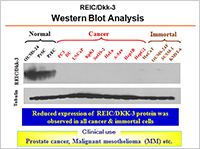
Caption: REIC/Dkk-3 Western Blot Analysis
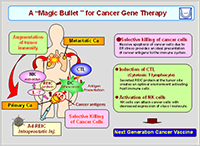
Caption: "Magic Bullet" for Cancer Gene Therapy
Research highlights
Anti-aging properties of drinking hydrogen-rich water on periodontal tissues
Oxidative stress is involved in age-related inflammatory reactions. Molecular hydrogen is considered to be a novel antioxidant that can reduce oxidative stress. Therefore, drinking hydrogen-rich water may suppress age-related oxidative stress and inflammatory reactions in the periodontal tissues. However, it remains unclear what the effects drinking hydrogen-rich water would be over the course of a lifetime.
Takaaki Tomofuji and colleagues at Okayama University have shown the anti-aging effects of drinking hydrogen-rich water on periodontal tissues.
Read more
Reference:
Tomofuji T, Kawabata Y, Kasuyama K, Endo Y, Yoneda T, Yamane M, Azuma T, Ekuni D, and Morita M, “Effects of hydrogen-rich water on aging periodontal tissues in rats, Scientific Reports 4, 5534 (2014).
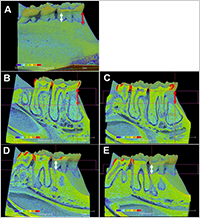
Caption: The 3D image model of the mandibular regions in rats (A). In the mesial root regions, the level of alveolar bone loss (white arrows) was greater in the control group (B) than in the experimental group (C). In the distal root regions (red arrows), the level of alveolar bone loss in the control group (D) was similar with that in the experimental group (E).
Shoulder and Elbow Surgery
Dr. Keiichiro Nishida, Associate Professor of Department of Human Morphology, Okayama University Graduate School of Medicine, Dentistry and Pharmaceutical Sciences, has developed a new linked elbow prosthesis (PROSNAP®) in cooperation with Kyocera Medical (Osaka, Japan) which possesses a unique assembly system, initially to be used for the relatively small bony structure of Japanese patients.
Read More
Reference:
Nishida K, Hashizume K, Nakahara R, Ozawa M, Harada R, Machida T, Nasu Y, Ozaki T, Inoue H, Short-term results of the PROSNAP® linked elbow prosthesis with a snap-in structure and modular flange for the reconstruction of severely damaged rheumatoid elbows, J Shoulder Elbow Surg; 23(6):837-42, 2014.
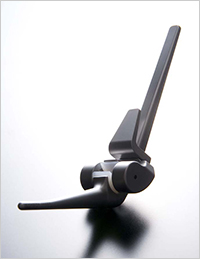
Caption: Fig. 1 Appearance of PROSNAP® elbow prosthesis
New Topical Hemostatic Agent: Neutral Self-Assembling Peptide Hydrogel
Self-assembling peptide is characterized by a stable β-sheet structure and known to undergo self-assembly into nanofibers that could further form a hydrogel. Self-assembling peptide hydrogels have already been employed for tissue engineering, drug delivery systems, and wound healing. In addition, self-assembling peptide hydrogels are effective as topical hemostatic agents. However, their low pH raises the possibility of harmful effects on living tissues.
Now, Seiji Komatsu and colleagues at Okayama University have demonstrated the efficacy of SPG-178 hydrogel, a neutral self-assembling peptide hydrogel as a topical hemostatic agent.
Read more
Reference:
Seiji Komatsu, Yusuke Nagai, Keiji Naruse, Yoshihiro Kimata, The Neutral Self-Assembling Peptide Hydrogel SPG-178 as a Topical Hemostatic Agent, PLOS ONE 9, e102778 (2014).
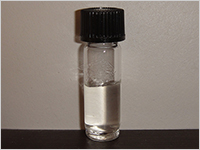
Caption: SPG-178 hydrogel. SPG-178 is a synthetic peptide with a neutral pH range. The primary structure is RLDLRLALRLDLR; R = arginine, L = leucine, D = aspartic acid, and A = alanine.
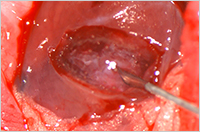
Caption: Hemostasis in a rat liver laceration model. Incision was made on the left hepatic lobe. Bleeding decreased immediately following application of the 1.5% (w/v) SPG-178 hydrogel to the bleeding surface. Because SPG-178 hydrogel is transparent, the bleeding surface was visible.
Next-Generation Sequencer applications: Innovation to turn ‘junk DNAs’ into genetic markers
A series of the Next-Generation Sequencer (NGS) applications are being developed to utilize ‘junk DNAs’ as distinctive genetic analysis systems for crop species.
Yuki Monden and colleagues at Okayama University, National Institute of Genetics, and Tochigi and Fukuoka Prefectural Agricultural Research Stations have prepared the NGS (HiSeq2000) sequence library of strawberry, which exclusively contains terminal sequences of a major retrotransposon type (LTR: Long Terminal Repeat), and have successfully identified the active groups using novel NGS sequence analysis.
Read more
Reference
Yuki Monden, Nobuyuki Fujii, Kentaro Yamaguchi, Kazuho Ikeo, Yoshiko Nakazawa, Takamitsu Waki, Keita Hirashima, Yosuke Uchimura, Makoto Tahara, Efficient screening of long terminal repeat retrotransposons that show high insertion polymorphism via high-throughput sequencing of the primer binding site, Genome, (2014).
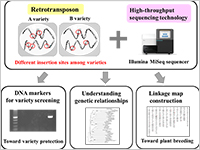
Caption: High-throughput sequencing of retrotransposon insertion sites and its applications.
Photoelectric dye-coupled thin film as a novel type of retinal prosthesis
Eye doctor Dr. Toshihiko Matsuo and polymer science engineer Dr. Tetsuya Uchida have been developing a new type of retinal prosthesis that is based on a photoelectric dye. The photoelectric dye is an organic molecule that absorbs light and converts light energy into electric potentials. The dye molecules are coupled to the surface of a film made of polyethylene. The polyethylene film (or polymer) is a biologically safe and stable material which is used, for example, as a component of artificial joints. The photoelectric dye-coupled polyethylene film, called Okayama University-type retinal prosthesis or OURePTM, can be implanted beneath the retina as a substitute for photoreceptor cells.
Read more
Matsuo T, Dan-oh Y, Suga S (Inventors). Agent for inducing receptor potential. Assignee: Okayama University. United States Patent. Patent No.: US 7,101,533 B2. Date of Patent: Sep. 5, 2006.
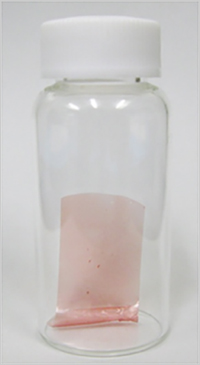
Caption: Figure 1. Photoelectric dye-coupled polyethylene film (OURePTM): a novel type of retinal prosthesis.
Further information
Okayama University
1-1-1 Tsushima-naka , Kita-ku ,
Okayama 700-8530, Japan
Planning and Public Information Division, Okayama University
E-mail: www-adm@adm.okayama-u.ac.jp
Website: //www.okayama-u.ac.jp/index_e.html
About Okayama University
Okayama University is one of the largest comprehensive universities in Japan with roots going back to the Medical Training Place sponsored by the Lord of Okayama and established in 1870. Now with 1,300 faculty and 14,000 students, the University offers courses in specialties ranging from medicine and pharmacy to humanities and physical sciences. Okayama University is located in the heart of Japan approximately 3 hours west of Tokyo by Shinkansen.
Website: //www.okayama-u.ac.jp/index_e.html